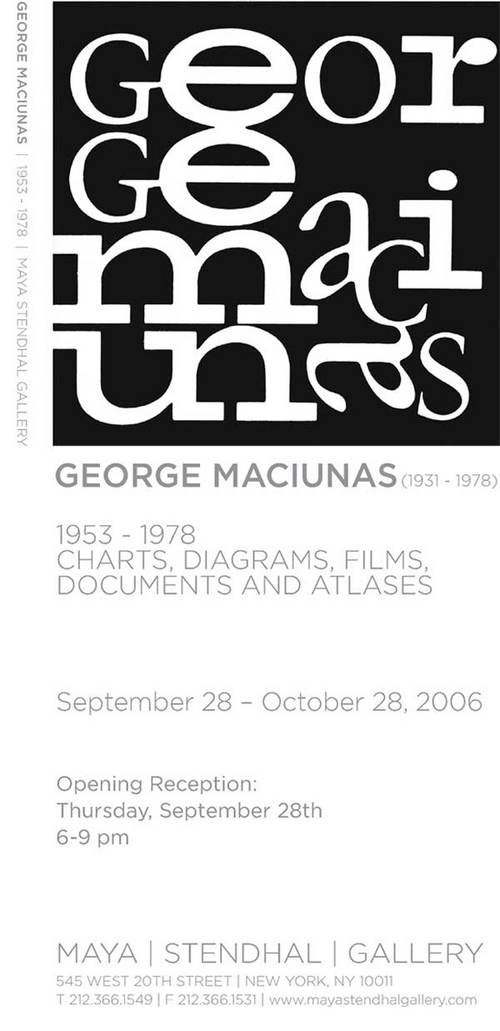George Maciunas
dal 27/9/2006 al 27/10/2006
Segnalato da
27/9/2006
George Maciunas
Stendhal Gallery, New York
Charts, Diagrams, Films, Documents, and Atlases. Created between 1953 and 1978, these "cultural timetables" reveal Maciunas' interest in visually displaying diverse information about historical periods. The artist's works make clear his desire to record artistic and sociopolitical chronological evolution.

Charts, Diagrams, Films, Documents, and Atlases
Maya Stendhal Gallery proudly announces the upcoming exhibition George Maciunas
1953-1978, Charts, Diagrams, Films, Documents, and Atlases.
The works on view are Atlas of Russian History, Prehistoric Chinese Art (Shang and
Chou Dynasties), European and Siberian Art of Migration, Biography Chronicling
Activity between 1939-1978, and Diagram of Historical Development of Fluxus
(incomplete). Created between 1953 and 1978, these "cultural timetables" reveal
Maciunas' interest in visually displaying diverse information about historical
periods. Maciunas' charts, diagrams, and atlases make clear his desire to record
artistic and sociopolitical chronological evolution. With these charts, he
introduced the 20th century as the era of "Art Genealogy".
Born to a Russian mother and Lithuanian father, Maciunas was an artist, art
historian, designer, architect, editor, producer, genealogist, typographer,
mathematician, musicologist, and leader of the 1960's international Fluxus
movement. Influenced by Marcel Duchamp's use of art beyond painting and John
Cage's experimental music, Fluxus deviated between the boundaries of art and
non-art through Maciunas' vision of artistic collaboration in various mediums. He
combined music, performance, visual arts, and literature to create one of the most
influential philosophies and artistic movements in modern art of the 20th century.
Maciunas did not spontaneously design his works, but rather preceded them with
eleven years of intensive studies at Cooper Union School of Art, the Carnegie
Institute of Technology and New York University. His widespread interests and
universalistic approach required a suitable form of knowledge management in order
for him to retain an overview of the enormity of the material. Charts, diagrams, and
atlases allowed him to reduce complexities, define limits, and make connections
between data. Maciunas made some three dozen of these historical diagrams between
1953 and 1978 which not only made clear political, economic, poetic, and aesthetic
relationships, but also predetermined the geo-historical framework of Fluxus.
Maciunas believed that the evolution of art could not be understood without an
orientation of a particular subject in context of time and space. In 1969, he
developed his theory of the "œLearning Machine"� which called for improvements in
methods of transmitting information. Maciunas criticized the rigid,
linear-narratives of books, lectures, or other traditional forms of learning for
their lack of communication of the layers and connections within history. Networking
thoughts into timesaving and efficient charts and diagrams, these "œLearning
Machines"� were also artistically and scientifically interesting.
Space and time, and their dissolution into succession, played an important role as
well. By breaking up the factual scheme, the work was extended into the third
dimension. The linear order of time is emphasized by Maciunas' attempt to uncover
the complexity of dates by chronologically coding history. He depicts history with
mathematical precision through a theory that time runs in cycles, depicted in his
charts by a formulaic wave curve. His model of time consisted of four phases;
origin, prosperity, maturity, and decline. Within these phases are both primary and
secondary cycles of time consisting of mathematical rules that systematize factual
relationships. In determining his time frame, Maciunas used dates and their
corresponding events to reduce history to technical means.
Maciunas titled his "œlearning machines"� in a scientific way so that his
intention was not always immediately obvious. For instance, his work entitled
Preliminary Unfinished Form of the Proposed Index Coordinate Graph actually explains
the history of art from the Visigoths to Metaphysical painting. Although Maciunas
uses epochal classifications such as Visigoth, Gothic, High-Renaissance, etc, as
clear conceptual definitions, he breaks down barriers between them by clarifying
sections of time. Maciunas left extra space in most of his charts to allow for new
ideas and new connections to be added, or to extend the timeframe. In discovering
new connections while he worked, Maciunas thematically linked several charts
together. He constantly made technical corrections, additions, and extensions.
With these documents, Maciunas criticized the rigid, linear-narratives of books,
lectures, or other traditional forms of accessing information. He felt that a linear
series of dates did not allow for the necessary communication of layers within
history. He therefore developed an accurate way to visually obtain knowledge and
quickly perceive themes. The dates, which make up his diagrams and charts, take on a
"Physiognomy", creating a three-dimensional reconstructed historical space.
Whether literally or symbolically, this idea of dimensions was communicated while
also limiting specialization. In learning, Maciunas believed it was important to
specialize only gradually. A wider range of understanding and orientation of time,
according to Maciunas, was necessary for professional success of any specialist.
This show provides a unique opportunity to view a rare body of work that has never
before been published or exhibited. The exhibition will run from September 28 "“
October 28, 2006.
Opening Reception: Thursday, September 28, 6pm-9pm
Maya Stendhal
545 W. 20th St. - New York



